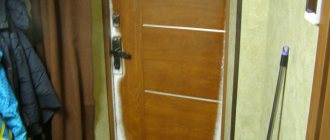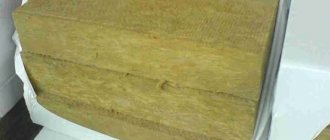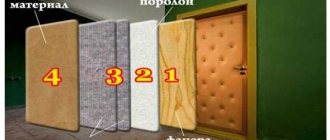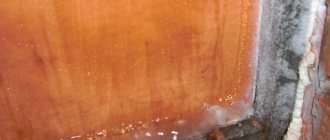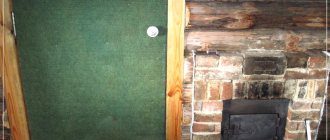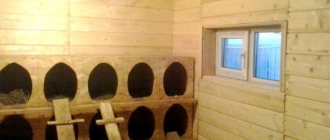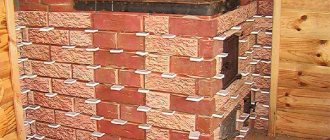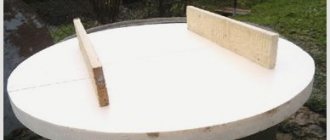Many domestic consumers often have a question: how to insulate a Chinese iron entrance door? Metal doors from Chinese manufacturers are very popular, because they are of good quality and reasonable price. Their only disadvantage is the absence of a layer of insulation, which is simply necessary under our climatic conditions. In order to understand how to insulate a Chinese iron entrance door, the video lesson will tell you quickly, and the article will tell you efficiently.
How to insulate an iron entrance door
You can insulate a door with your own hands in several ways:
- between cladding panels;
- from the side of the room;
- from the entrance or street.
The complex of installation work is different in each case. In the first option, when insulating between the upholstery panels, it is necessary to carry out work on dismantling and installing the structure of the entrance panel and the frame.
Required materials and tools
To perform the work you will need tools that every owner has. These are screwdrivers, scissors, a screwdriver, pliers, and a tape measure. Mineral wool or polystyrene foam can be glued to Titan or Moment glue or liquid nails. A door insulated with your own hands will delight you for many years.
External sound insulation
It can be produced using vibration and sound insulating materials on an adhesive basis, as well as using durable glue or liquid nails. Polystyrene, vibroplast, bitoplast, bimast can be used. We degrease the surface of the door and glue the self-adhesive sheets with smoothing movements. Or we evenly distribute the glue and liquid nails and fasten the sheets of material in the same way. Carefully cut off the excess with a mounting knife. Smooth the edges and, if necessary, glue the lagging parts. It is advisable to paste the inside and outside of the door.
Alternative methods
In addition to polystyrene foam to insulate a Chinese entrance door, you can use other materials. These can be ready-made, commercially available insulation materials.
Installation, as a rule, is carried out along the entire perimeter and is fixed with leatherette strips. After installation, be sure to check the entire area for gaps, joints, cracks or holes. They shouldn't exist. You can eliminate them using improvised means (foam rubber or leatherette).
What to do with one-piece fabric
It would be very convenient if doors from Chinese manufacturers initially had a layer of insulation. But since this option helps us save money, we prefer to fix the shortcomings ourselves.
In the case of an integral leaf, it is necessary to modify the inside of the door and install a new lining.
All work takes place in several stages:
- the entire internal part is completely eliminated;
- another frame is pre-created;
- Self-tapping screws are screwed into the wood and secured with a layer of putty. After which they are painted or varnished.
- Now you can start direct insulation. All material is fixed with glue.
- all this is covered with a sheet of chipboard, which must be measured and cut in advance;
- All that remains is to apply a layer of foam rubber and cover it with leatherette.
Keep in mind that after sealing, the dimensions of the door will become much larger, so you need to prepare the appropriate fittings in advance.
Preparing to repair a Chinese door
You need to stock up on four plates:
- 2 mm thick,
- 400 mm long,
- 50 mm wide.
Unwind the bottom loop. Most likely, there will be a plate that was welded to the end of the door on the reverse side with two tacks. In the case under consideration, it came off with a piece of this end.
To unwind the loop, you need hexagons. As a last resort, you can use a key from a small grinder - for example, if it has a hexagon for dismantling the casing.
Step-by-step technique for thermal insulation of street doors with foam plastic ↑
Thermal insulation of street doors made of two-millimeter metal sheet and profile pipe is carried out both from the inside and from the outside. If forging elements were used when finishing the door leaf, then the insulation of the metal entrance door is done with your own hands only from the inside. In this case, various heat-insulating materials are used: insulation and sealants.
Weaknesses in the thermal insulation of iron doors
They begin work with preparatory activities related to measurements of individual structural elements and the acquisition of necessary materials:
- The depth of the cells formed by stiffening ribs made of a profile pipe is measured.
- Buy polystyrene foam of a thickness suitable for this measurement.
- All cells are measured in length and width.
- Foam blanks are cut into rectangular tiles, sparingly using the area of the entire sheet. The slabs are deliberately prepared slightly larger than the measured values to ensure a tight fit of the material into the cell between the profiles.
- Insulation blanks for an iron door are numbered so that you don’t waste time choosing the right part.
Comparison of foam plastic
Next, they begin to lay the cut pieces of foam plastic in the cavity of the “skeleton” of the door. To securely attach the heat-insulating material to the iron sheet, polyurethane foam is used.
Applying foam with a gun
The work is carried out in the following sequence:
- Take a can of polyurethane foam and shake it vigorously.
- Turn the can upside down and begin to apply foam using a special gun, first around the perimeter of the cell, and then make several parallel foam lines inside it.
- Insert the workpiece with the required number into the cavity, pressing it against the applied foam.
- Move to the next cell, repeating all operations again.
- Then all the cracks and joints between the insulation and the profile, as well as between the composite pieces of foam plastic used to save money when insulating a cell with a door lock, are foamed.
Laying foam plastic slabs in cells
Installation procedure:
- The insulated door leaf is covered from the inside with a single-cut sheet of moisture-resistant plywood, which has a beautiful dark glossy surface that does not require additional finishing.
- To install the plywood sheet, the door is removed from its hinges and placed horizontally on two supports.
- A special U-shaped strip with a pocket into which a plywood sheet and an MDF sheet will be inserted is screwed to the iron frame on three sides (sides and bottom). The size of the pocket is calculated based on the thickness of the plywood, MDF panel and the height of the protruding screw heads.
- Cut from a standard size sheet of plywood and MDF panels of the required size. Insert them into the side U-shaped slats and push them to the bottom pocket, making sure that the sheets fit tightly and evenly into it.
- The top bar is made removable so that, if necessary, you can easily remove the damaged MDF sheet and replace it with a new one.
- The top strip is glued with silicone glue, applying it with a gun to the side of the plywood sheet and MDF panel.
See more details about the method of insulating the door leaf in the video.
Video: How to insulate the front door
Thermal insulation diagram
Here's how to quickly and easily insulate an iron door from the inside, making it an integral part of the hallway interior.
Before hanging a sheathed and insulated door on its hinges, do not forget to make a slot for installing the door handle, and it is better to install the accessory itself in advance. Otherwise, you can slam the door and remain closed in the room.
Please note that outdoor insulated metal entrance doors are thicker than the original version. This may result in the key not being long enough to open the lock. The problem is solved by lengthening the key. If you have a lever mortise lock, then the key should be long enough.
Due to the thickening of the door leaf, the square on the latching handle is also lengthened. The connecting rods of varying lengths required to install door handles on both sides are sold as separate door hardware items.
Standard thermal insulation pie
To prevent doors from blowing through the gap, D-shaped self-adhesive rubber seals are used. Before gluing the sealant, degrease the surface by wiping it with white spirit. Then remove the protective film and press the seal against the door frame around the entire perimeter.
An overlap of two seals is made in the corners, and then both materials are cut at an angle of 45 degrees with a sharp knife. Remove excess pieces by carefully gluing together the edges of the seals that meet in the corner.
Other options for insulating steel doors from Chinese manufacturers
In practice, there are several more options for answering the question of how to warm a Chinese entrance door. This can be done in the following ways:
- Making an outer layer of insulation that is attached to the outside or inside of the sash using glue or self-tapping screws. It is also allowed to cover the heat-insulating material with leatherette, vinyl leather or other leather substitutes;
- Insulation of slopes of the entrance structure and the space between the frame and the opening. This method of performing work is very effective, however, it requires quite a lot of labor;
- Replacement of seals installed around the perimeter of a Chinese steel door. In most cases, manufacturers save on purchasing high-quality rubber profiles. As a result, seals quickly fail. Replacing them does not require serious financial investments and large labor costs.
Do not forget about such options for solving problems with insufficient insulation parameters of a Chinese product, such as installing a second door in the opening or installing a vestibule entrance structure on a common floor area. Both methods are often used in practice, as they combine efficiency and a reasonable level of costs required for the work.
In order to reliably insulate metal entrance doors
the cause of the heat leak must be determined. Most often, it lies in the wear of the rubber seals, and replacing them will be a sufficient measure. In some cases, adjustment of the structure is required and, in more serious cases, its alignment using special equipment.
First, the gaps in the frame and the door frame are eliminated. The presence of cracks can be checked visually or by pressing, the existing play is eliminated. In the places where the box is attached to the walls, the old foam may come off; such places need to be re-foamed or simply plugged. Many people mistakenly believe that glued sealing rubber (the same as on metal-plastic windows) will improve the insulation of metal doors
. Such a seal will only add problems, since the metal structure has no gaps. The perimeter of the vestibule must be covered with foam rubber sealant. It is glued to the frame profile, closer to the inner edge. If the thickness of the foam is greater than the thickness of the gap, one edge is cut off at an angle. When closing the profile, the door leaf should be pressed against the foam rubber only near the very edge on the inside.
Most often, metal door structures are made from a corner or square pipe, which creates cavities inside the door leaf. Insulation of metal doors involves filling this cavity with heat-insulating material. Most often, foam plastic with a thickness equal to the depth of the internal cavity is used for this. The foam is laid in such a way that there are no empty spaces left. It is glued with liquid nails. The resulting gaps are blown out with polyurethane foam, and after drying, proceed to the next stage.
The use of laminated fiberboard will allow better insulation of metal entrance doors, as it will cover the unaesthetic appearance of foam plastic. It is more convenient to fasten fiberboard with metal screws, having previously drilled holes. Fiberboard sheets are fixed in the desired position using clamps, holes are drilled through the sheet and screws are screwed in. It is recommended to fasten from top to bottom; as you fasten, the sheet will gradually level out.
Recently, people have increasingly become interested in how to insulate a Chinese door
, stamped from thin tin and having a lattice paper filling inside. Chinese structures have all the joints with the door block fitted quite well; the paper filling makes them warmer than ordinary hollow ones, but they will have to be insulated. Thermal insulating material made of foamed polyethylene (10mm) is glued to the inside; you need to choose a material with a smooth and dense soft surface. After insulating a Chinese door with such material, it can be spray painted with brown (or any color) paint. The result is an original door leaf with imitation leather.
We insulate the door frame
The frame of the metal door leaf is made from an iron angle, which is secured in the opening with anchors. After removing the old door structure, large gaps often remain between the mounted door frame and the load-bearing wall or partition. When installing, builders blow them with polyurethane foam, but it has a certain drawback: the material is afraid of sunlight. If sections of the foam are not protected from ultraviolet radiation in time, it will crumble into dust over time.
The old deteriorating foam from the box must be removed and insulated again
How to do it correctly:
- We clean the wall adjacent to the doorway from the remnants of the polyurethane foam, spread the plaster down to the brick or concrete and remove the dust.
- Spray the surface with plain water and foam the visible indentations. The foam will stick better to the wetted wall.
- When the material hardens, cut off the excess.
Types of thermal insulation materials
There are many thermal insulation materials on the construction market that are suitable not only for insulating a variety of surfaces, but also for door structures, these include:
- mineral wool slabs,
- basalt wool,
- foam rubber,
- perlite,
- foam boards or polystyrene foam.
To fill gaps and cracks, polyurethane foam is used, which acts as both a heat and sound insulator.
Insulation for doors
Which insulation for the front door is better?
There are many materials that can solve the problem of insulation, here are just some of the widespread ones:
Expanded polystyrene. Inside this material there are many micropores with air, due to which the thermal insulation characteristics of the door leaf remain high. The upholstery base does not play a role in this case.
Related article: Decorating interior doors - an original approach to interior decoration
Polyurethane foam. It is considered optimal among other solutions existing today. It is used both in rural areas and inside city apartments. But this material is expensive, and moreover, it is difficult to apply to wooden surfaces.
Izolon. This is a type of polyethylene foam, a member of the group of ordinary foam rubber. The cost of the material is also high, but the result pays for all the costs.
Mineral wool. This is a material that guarantees thermal insulation performance at a fairly high level. The only disadvantage we can highlight is the ability to accumulate moisture. In addition, mineral wool may sag over time.
Foam rubber. This is a type of porous material available to almost everyone. The ease of installation makes it popular even among those who live in rural areas. The most budget-friendly type among insulation materials, it can be installed even on the street part of the structure.
Styrofoam. An ideal solution if you need to insulate the entrance structure from the inside. It is distinguished not only by its low cost, but also by the fact that even over many years it does not change its original appearance.
Dismantling the door frame
A metal door frame is a frame that is secured to the wall with metal pins or anchor bolts. If bolts were used for fastening, you can try to unscrew them with a wrench. But usually the fastening of the old door has long since rusted, so it is hardly possible to dismantle it without an angle grinder.
You will need to very carefully cut down the existing pins or anchors. When access to them is difficult, you will have to knock off a little of the concrete wall. Then, using a hammer and a crowbar or crowbar, we tear the box off the concrete. After this operation, it usually gives in easily and is removed from the opening.
We do the same thing if the metal frame of the front door is welded to the fittings driven into the wall. Using a grinder, we cut off the fastening rods around the perimeter of the box on which the structure is secured. For this reason, you often have to knock out a hole in the concrete with a hammer drill so that the grinder can fit in there. And then we manually remove the remnants of the reinforcement and pieces of plaster that hold weakly.
Typically, between the door frame and the wall there is a seal - a layer of polyurethane foam. To free the door, you need to cut the old seal with a knife. Residues that have not been removed can be treated with coarse sandpaper. Metal pins remaining in the doorway are usually not removed, since part of the wall can be destroyed along with them. Just when installing a new door, its fastening should be positioned slightly higher or lower than the old one.
Prices for services
| Services | Price |
| We will replace the lock | from 1000 rub. |
| — level | 1000 - 2000 rub. |
| - cylinder | 1000 - 2000 rub. |
| - disk | 1000 - 2000 rub. |
| — screw | 1000 - 2000 rub. |
| - interior | 1500 rub. |
| - fire protection | 1500 - 2000 rub. |
| - crusade | 1500 - 2000 rub. |
| - crossbar type | 2000 - 3000 rub. |
| - on the gate | 2000 - 3000 rub. |
| - at the gate | 2000 - 3000 rub. |
| - garage | 3000 - 4000 rub. |
| - magnetic | 3000 - 4000 rub. |
| — electromechanical | 3000 - 4000 rub. |
| — electric | 3000 - 4000 rub. |
| — postal (including mechanism) | 1500 - 2150 rub. |
| - in a plastic door | 1500 - 2000 rub. |
| Let's replace the larva | from 700 rub. |
| - cylindrical | 700 - 1500 rub. |
| - disk | 1000 - 1500 rub. |
| - pin (English) | 1000 - 1500 rub. |
| - crusade | 1500 rub. |
| - in a plastic door | 1000 rub. |
| Let's open the lock, the door | from 1000 rub. |
| — cylinder responsible or imported (without protection) | 1000 - 2000 rub. |
| — lever without damage to the door leaf (without protection) | 2000 - 3000 rub. |
| - interior | 2000 rub. |
| - garage | 1500 - 4000 rub. |
| - door latch | from 1800 rub. |
| - protective element | 1200 - 1800 rub. |
| - on the mailbox | from 500 rub. |
| — diagnostics of mechanisms | 1000 rub. |
| Let's install a lock | from 1000 rub. |
| — magnetic with keys (10pcs) Touchmemory | 8800 rub. |
| — with cards (10pcs) | 9500 rub. |
| — additional cards (keys) | 30 - 80 rub. PC. |
| - radio controlled - invisible | from 8500 rub. |
| — electromechanical | from 4000 rub. |
| - biometric | from 2000 rub. |
| — electronic | from 2000 rub. |
| — Barrier | 3000 - 4000 rub. |
| Let's open the car | from 1500 rub. |
| — imported | 1500 to 2500 rub. |
| - premium segment | 2500 - 3000 rub. |
| - trunk, hood or gas tank | 1500 - 2500 rub. |
| — motorcycle equipment | 900 - 2000 rub. |
| Let's open the safe | from 1500 rub. |
| - domestic | 1500 - 2000 rub. |
| — imported | 2000 - 2500 rub. |
| — electromechanical | 2000 - 3000 rub. |
| Safe repair | from 1500 rub. |
| Locks | |
| Repair | 1500 - 3000 rub. |
| Lubrication | 200 rub. |
| Inset | 2000 - 4000 rub. |
| Recoding | 1500 - 2000 rub. |
| Replacing a replaceable secret block (nucleo) | 2000 rub. |
| Doors | |
| Repair (check by phone as each case is individual) | from 2000 rub. |
| Maximum Protection Discount | 20% |
| Removing from hinges and reinstalling | 1000 rub. |
| Parsing / collecting | 1000 - 3000 rub. |
| Reconstruction after autopsy of the Ministry of Emergency Situations, Riot police | Negotiable |
| Fire recovery | Negotiable |
| Noise insulation | from 2000 rub. |
| Insulation | from 2000 rub. |
| Installation of protective armor plate | 1800 - 3500 rub. |
| Latch insert | 1700 rub. |
| Gate valve insert | 2000 rub. |
| Installation of door hardware | from 1500 rub. |
| Decorative MDF panel with works (side) | from 4800 rub. |
| Metal door trim (standard 200Х90) one side | from 1500 rub. |
| Quilting with decorative nails (per 1 pc.) | 30 to 60 rub. |
| Rollers around the perimeter | from 1000 rub. |
| Visit of a specialist to show samples, take measurements and prepare an estimate for upholstery (not charged when placing an order) | 500 rub. |
| Welding work | from 2000 rub. |
| Overcooking loops | 3000 - 5000 rub. |
| Restoration of hinges | from 1500 rub. |
| Modification of the door response, adjustment of locking mechanisms | 1000 - 2000 rub. |
| Replacement of handles (installation, strengthening) | 1500 rub. |
| Correcting skew | 1500 - 3000 rub. |
| Adjusting the hinges | 1500 rub. |
| Sealing seal | from 1700 rub. |
| Installation and replacement of customer mechanisms | from 2000 rub. |
| Peephole insert | 1100 rub. |
| Replacing the eye | 200 rub. |
| Installation of closer | 2000 - 3000 rub. |
| Installation of video intercoms | from 3500 rub. |
| Access Control System | from 3500 rub. |
| False call | 500 rub. |
| Works not listed in the price list | Negotiable |
Official registration of completed work. Warranty up to 3 years. The visit of the master is FREE.
*prices are for work. *free visit of a specialist when placing an order.
In order to isolate the room from extraneous noise, it is recommended to install well-insulated interior doors and cover the walls with special soundproofing panels.
We insulate the door with foam panels
So, in order to fully understand all the intricacies of this difficult issue, we will try to tell you about everything in order.
Necessary tool
Before you start insulating the door, prepare the tools you will need for the work:
- Rolled insulating foam;
- Foam panels, the thickness of which corresponds to the thickness of the metal profile;
- Jigsaw;
- Knife;
- Set of drills (for metal);
- Several bits (installed on a drill or screwdriver);
- Medium grit sandpaper;
- Marker;
- Roulette;
- Screwdriver;
- Ruler;
- Drill and screws;
- Sealant or silicone;
- Fiberboard sheet;
- Screwdriver and drill;
- Self-adhesive paper or film.
Foam panels of different thicknesses
Rolled foam
Fiberboard
Sealant
Work plan
Well, we’ve figured out the tool, now let’s move on to the question of how to insulate an iron door in a private house.
This instruction will tell you step by step what to do and how to do it:
- First you need to measure the height and length of the door leaf. This is necessary in order to then cut out a sheet of fiberboard that will completely cover the insulation;
- We transfer the obtained dimensions to the fiberboard sheet;
- We mark the location of the lock and peephole on a sheet of chipboard and cut out the corresponding holes for them;
- We attach the finished part to check the size ratio and compliance with all the necessary holes;
Prepared fiberboard sheet
The next step is to fill the door with foam panels. In order to cut the insulation for an iron door, we use a knife. We do not spare silicone and apply a rich layer of it to the inside of the door (this measure is necessary so that the panels do not fall out);
Filling with foam panels
Now, you need to screw the fiberboard into place. We insert a special bit into the screwdriver and use self-tapping screws to screw it to the door.
- We tighten the screws along the entire perimeter of the sheet. The most important thing in this matter is that the sheet of plywood lies tightly, without swelling;
- Now you need to take a knife and plan off the excess edge that protrudes slightly beyond the profile;
- The last step is to take medium-grain sandpaper and carefully grind down the edges of the fiberboard so that the structure has an attractive and finished look.
This photo shows that all the cracks are carefully filled with polyurethane foam.
The door stiffeners, since they are made of metal, will keep the cold in. Profile pipes and corners freeze in winter and create an unpleasant refrigerator effect.
To avoid this, it is necessary to fill the stiffeners (tubes) with polyurethane foam. In order to do this, you will need a drill, which makes a hole in the profile pipe. Then the pipe is filled with foam.
Work execution technology
To carry out the insulation process of a standard metal structure, you will need to proceed in several stages:
- Initially, you need to measure the dimensions of your door along with the profile. Please note that the fiberboard sheet, which is intended for covering the door frame on the inside, must completely hide the profile of the structure. Once the measurements have been taken and the sheet is cut according to the measurements, mark and cut out the holes for the peephole and keyhole;
- Using foam panels cut to size, fill the gap equal to the thickness of the frame profile by fixing them to the metal surface with silicone glue;
- Secure the prepared fiberboard sheet on top using special screws screwed into the metal profile through the fiberboard. Make sure the screws are spaced evenly across the entire surface. Then sand the edges of the sheets using a knife and sandpaper;
- After finishing processing the door leaf, cover it with sealant (foam rubber). To do this, secure the material to the frame, having first removed the protective film from it.
At this point, the insulation work is completed, and you can enjoy the acquired silence and warmth of your apartment, thanks to the insulated iron door.
If you have Chinese doors installed, then over time they will also need to be insulated. Although some people insulate them immediately after purchase. Below we offer you detailed instructions on how to carry out insulation work:
- The first step is to disassemble the door structure. So, on one side you completely remove the fittings and, if any, the upholstery.
- If, when dismantling the facing sheet, it was not possible to maintain its integrity, then it’s not scary. It can be replaced with a sheet of fiberboard. Thanks to this, you will save time during assembly when selecting the intricate configuration of a Chinese bolt or other part.
- Next, install a wooden frame around the perimeter of the door, securing it to the leaf with metal screws. The thickness of the slats can be up to 20 mm, equal to the thickness of the foam.
- Now fill the entire space inside the slatted structure with foam plastic. For this work, it is recommended to use special glue that will not deform the foam. Thanks to gluing, the foam will not hang around inside the door and therefore crumble. The gaps between the insulation are also filled with glue.
- When choosing polystyrene foam, give preference to the material that has a higher density. And given that the price of this insulation is low, it will be possible for everyone to buy it.
- As we have already said, we will cover the door frame with fiberboard sheets. The fiberboard sheet is secured to the metal with self-tapping screws. It is recommended to use clamps for this work. To make it easier to unscrew the screws in the future, it is recommended to first drill a hole in the frame.
- As in foam plastic, so in fiberboard, make appropriate holes for the peephole, door lock and other door elements.
- After preparing the fiberboard and gluing the foam, cover it with foam rubber on top and cover it with the final covering (fibreboard). In this case, the thickness of the foam rubber should be such that the fiberboard sheet can be secured without much effort.
- Finally, cover the surface with leather or other finishing material. For beauty, you can also put foam rubber under the upholstery and, having thought through the shape, hammer in nails with a decorative head.
- Now you can install the fittings and hang the doors on their hinges.
Due to the increase in door thickness after insulation, you may need to replace the door lock or handles. Think about this before carrying out work, otherwise you will have to sleep with the doors open!
Common mistakes when insulating
Insulating metal doors is a fairly simple and straightforward process, so it is not necessary to involve professionals to carry out the work.
Having decided to remake it yourself, it is important to adhere to the described algorithms. To avoid unnecessary mistakes, take note of these simple tips:
- When insulated, the door becomes thicker than it was originally. This fact must be taken into account when selecting accessories - locks, handles, peepholes.
- You should not carry out insulation work while the door is in a vertical position. This will not only complicate the process, but will also lead to displacement of the insulation.
- When using polyurethane foam to fill joints, it is worth considering its ability to expand. When dried, its volume increases 2-3 times, which can compromise the integrity of the structure.
- When installing a new iron door, it would be useful to leave the old wooden one. Thus, the air space formed between the canvases will help enhance the heat and sound insulation properties.
- If, after laying the insulation in the cells of the frame, gaps have formed, they can be eliminated using pieces of polystyrene foam or polyurethane foam.
Following these tips will help you achieve good results and avoid annoying mistakes when insulating your home. Knowing how to insulate an iron door yourself, you won’t have to turn to the help of professionals.
Insulation of the door leaf
Cheap Chinese doors are usually made without internal insulation, so the owners have to modify the design themselves.
The better to insulate
Before insulating the entrance metal door of an apartment, you need to decide on the type of filler in the interior space of the door leaf. Depending on the internal structure of the door, use:
- polystyrene foam boards or polystyrene foam;
- bulk materials (sawdust, expanded clay);
- polyurethane foam;
- thermal insulating mineral boards.
Polyurethane foam is considered more reliable and durable, but due to its high cost it is not used often; polystyrene foam and mineral wool insulation are much more popular.
Insulation with mineral wool slabs.
Materials and tools
Before insulating an iron door from the inside, you will need to purchase material and prepare the necessary tools:
- material selected as insulation;
- polyethylene film;
- wooden blocks with a cross-section corresponding to the thickness of the internal space of the door leaf;
- self-tapping screws;
- metal reinforcements for wooden frames (corners, profile);
- electric drill;
- construction knife;
- liquid Nails;
- hacksaw;
- Screwdriver Set.
Before insulating the iron entrance door from the outside, you will additionally have to purchase:
- dermantin or eco-leather;
- felt material.
Insulation instructions
Work on insulating the inner and outer parts of the canvas is different. Most often, internal insulation of the door is carried out, because... in this case it has to be disassembled.
Inside
To place insulation inside a metal door you will need to perform the following steps:
- the door is removed from its hinges and installed on a hill;
- dismantle handles, locks and latches;
- dismantle the fiberboard sheet from the inside of the door;
- take measurements of the internal space to prepare the wooden frame;
- individual elements for the frame are cut from the block;
- an adhesive composition is applied inside the door leaf and a plastic film is laid;
- assemble the frame (when assembling, you should take into account the locations of the locks and through handles);
Installation of a wooden frame. Foaming the gaps between the frame and the door.
- to enhance the rigidity of the frame, corner joints are reinforced with iron corners;
- Insulation is placed inside the frame cells;
- glue is applied to the sheathing, after which the top is covered with plastic film;
- small cracks and gaps not filled with insulation are filled with polyurethane foam;
Filling the seams between the insulation and the frame.
- the inner fiberboard sheet is returned to its place and secured with self-tapping screws;
- the door is hung on hinges and handles, locks and latches are inserted.
Outside
If it is necessary to sheathe the outside of a steel door with eco-leather, perform the following work:
- The door is removed from its hinges and placed on a hill.
- The felt insulation is cut to size and glued to the door leaf using glue (a 20 mm indentation is made along the perimeter of the door leaf).
- Eco-leather or dermantine canvas is cut to exceed the dimensions of the canvas by 50 mm.
- Dermantin is glued with a bend to the inside of the door leaf, and it is necessary to maintain uniform tension on the material.
- A metal strip is stretched around the perimeter of the door leaf, securing it with self-tapping screws. The tape serves as an additional fastener for the sheathing.
To obtain a decorative surface, you can additionally secure the material to the surface of the door using special self-tapping screws with curly heads.
Required materials and tools
Prepare the necessary equipment and materials.
Tools:
- electric drill,
- jigsaw;
- sharpened cutter,
- screwdrivers,
- hammer,
- screws,
- tape measure, pencil and ruler.
Materials:
- thermal insulation material,
- adhesive tape,
- sandpaper,
- wood fiber boards,
- sealant.
The purchase of thermal insulation material is made according to the dimensions of the door leaf; it must be the same width as the end of the steel door (taking into account the cladding on both sides), and the area must be equal to the area of the cells between the stiffeners of the door frame.
What to do with one-piece fabric?
Of course, it would be great if the iron door from China was initially insulated. Since it makes the finished product more expensive, it is customary for us to take a budget option and improve it using our knowledge. In the case where the entrance door structure has one-piece panels, you need to prepare to adjust the internal appearance of the door leaf and make a new overlay. But first things first:
The door completely gets rid of the fittings located inside. An additional frame is made, as in the photo. To do this, wooden planks are fixed along the entire internal contour of the canvas with metal screws, the width of which should be similar to the width of the insulation. It is very good if the holes for the screws are prepared in advance in the metal base, and their diameter is slightly smaller than the circumference of the fasteners themselves. At this stage, it is recommended to secure several transverse slats, and all wooden elements should be pulled tightly to the metal base. The screws have to be screwed into the wood, the fixation points must be sealed with wood putty, after which all wooden parts are first painted or varnished. Afterwards, the Chinese door is filled with the selected insulation, which would be good not only to press and squeeze perfectly into the newly created frame, but also to fix it with “Dragon” type glue. All this is covered with a sheet of fiberboard of the required dimensions, which, again, is attached with screws or even nails to wooden planks. Foam rubber is placed on top, over which a good leatherette is stretched. The latter is attached with non-traditional nails with decorative or hidden heads.
The whole process can be followed in much more detail using the video. Since after similar insulation of the door leaf it becomes much wider, it is important to purchase the necessary fittings.
At the final stage, it is important to fill with installation foam all the voids and cracks found between the box and the wall. After it dries, everything is cut off unnecessarily with a sharp utility knife, and the joint is sealed with putty or cement.
Alternative methods
If you decide to protect a private house with a Chinese door, try to make sure that all its seams are tight. Then it will be possible to insulate
construction by filling the internal cavities with vermiculite or perlite.
And one more thing: do not rush to free yourself from the ancient entrance canvas. Try to live with 2 doors, between which there will be an air cushion. It has excellent sound and heat insulation abilities, and is quite capable of replacing self-made insulation with hundredths and keeping the metal sheet from freezing.
Chinese door repair.
Metal entrance doors, made by the hands of hardworking Chinese, have firmly settled in the apartments and houses of domestic citizens. And it’s not surprising, because their price, relatively good workmanship and versatility of appearance invariably attracts and attracts people. Unfortunately, such structures have one significant drawback - the lack of a good insulation layer, which is unacceptable in our climatic conditions.
We insulate a Chinese door
As usual, craftsmen quickly got their bearings and found ways to insulate Chinese door panels in order to retain precious heat in the house. It turns out that if you have a minimum set of devices and skills in handling them, it is quite possible to make a real wall out of a budget door, through which not a single draft will pass. Sounds tempting, doesn't it?
This article offers options on how you can insulate detachable and one-piece entrance panels from China with your own hands.
Conclusion
Insulating a Chinese metal door is a process that will help significantly improve the performance of such a product. Since the majority of Chinese manufacturers do not pay special attention to insulating the door leaf from heat loss, insulation can be safely called mandatory for every person who has chosen such a leaf for themselves.
After thermal insulation, even Chinese doors will help retain heat in the house, creating optimal conditions for comfortable living. If any questions arise during the insulation process, you can always watch the video in this article, where everything is shown quite accessible and understandable.
Features of insulation of a metal split door
The algorithm for insulating a metal split door is not much different from the process of thermal insulation of a conventional iron door leaf. The design feature of the door plays a key role here.
Sectional view of a metal split door
The door is removed from its hinges, laid on a horizontal surface, all functional and decorative elements in the form of a peephole, handles, locks and plugs are dismantled, then the internal lining is dismantled (if the product is not monolithic, then the trim is attached with self-tapping screws). In the case of insulation of a non-removable door, the inner lining can be carefully cut with a grinder. When the product is disassembled, cardboard is removed from the cavities and the door is cleaned of any remaining debris and dust.
Next, a water barrier is installed, the insulation is cut and attached (remember that some materials do not require moisture protection). The insulation process itself is as simple as in the example with a one-piece door.
The overlay is installed in place. If it becomes unusable after dismantling, the interior design of the door can be replaced. Then the peephole, locks and handles are put in place and the product is installed in the box.
In order not to spoil the integrity of a non-removable Chinese door, it is insulated over the skin
In the case of a monolithic door, if there is no particular desire to spoil its integrity, you can insulate it on top of the existing casing. To do this, a lathing made of timber is attached to the demonstrated and disassembled door leaf from the inside and outside. All further actions are practically no different from the previous algorithms.
Door design options
The most common two options for installing entrance doors are detachable (collapsible) and permanent (non-removable). One-piece doors have the following features:
- The basis of the frame can be not only a metal profile, but also a simple metal strip or corner;
- there may be no internal stiffeners;
- the casing is made of thin metal and welded to the frame.
Detachable structures involve fastening the casing not with welding, but with self-tapping screws. This slightly increases the cost of the door, but greatly improves its maintainability and simplifies modernization. In addition, to facilitate the installation of panels, most manufacturers use a metal profile, which has a beneficial effect on the mechanical strength of the structure. Detachable structures often have internal lining made of decorative materials.
In addition to the frame, insulation and cladding, Chinese metal entrance doors are supplied with the following elements:
- door frame. Most often made of metal. In cheap options, it may not be included in the price, but must be purchased separately;
- lock and handle. Can be combined or installed separately; Some lock models are equipped with vertical locking bolts, which increases the vandal resistance of the structure
- peephole
To increase mechanical strength, the doors are equipped with stiffeners made of metal corners. They are located in the inner part of the frame.
